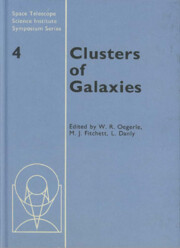Book contents
- Frontmatter
- Contents
- Preface
- Participants
- Chapter 1 Cosmology and Cluster Formation
- Chapter 2 Clusters of Galaxies: Structure, Infall, and Large-Scale Distribution
- Chapter 3 Cosmogony with Clusters of Galaxies
- Chapter 4 Cosmogony and the Structure of Rich Clusters of Galaxies
- Chapter 5 The Dark Matter Distribution in Clusters
- Chapter 6 The Effect of the Cluster Environment on Galaxies
- Chapter 7 Evidence for Gas Deficiency in Cluster Galaxies
- Chapter 8 Properties of Galaxies in Groups and Clusters
- Chapter 9 Dynamical Evolution of Clusters of Galaxies
- Chapter 10 Hot Gas in Clusters of Galaxies
- Chapter 11 Hydrodynamic Simulations of the Intracluster Medium
- Chapter 12 Evolution of Clusters in the Hierarchical Scenario
- Chapter 13 Distant Clusters as Cosmological Laboratories
- Chapter 14 Future Key Optical Observations of Galaxy Clusters
- Chapter 15 Cluster Research with X-ray Observations
- Plate section
Chapter 5 - The Dark Matter Distribution in Clusters
Published online by Cambridge University Press: 06 July 2010
- Frontmatter
- Contents
- Preface
- Participants
- Chapter 1 Cosmology and Cluster Formation
- Chapter 2 Clusters of Galaxies: Structure, Infall, and Large-Scale Distribution
- Chapter 3 Cosmogony with Clusters of Galaxies
- Chapter 4 Cosmogony and the Structure of Rich Clusters of Galaxies
- Chapter 5 The Dark Matter Distribution in Clusters
- Chapter 6 The Effect of the Cluster Environment on Galaxies
- Chapter 7 Evidence for Gas Deficiency in Cluster Galaxies
- Chapter 8 Properties of Galaxies in Groups and Clusters
- Chapter 9 Dynamical Evolution of Clusters of Galaxies
- Chapter 10 Hot Gas in Clusters of Galaxies
- Chapter 11 Hydrodynamic Simulations of the Intracluster Medium
- Chapter 12 Evolution of Clusters in the Hierarchical Scenario
- Chapter 13 Distant Clusters as Cosmological Laboratories
- Chapter 14 Future Key Optical Observations of Galaxy Clusters
- Chapter 15 Cluster Research with X-ray Observations
- Plate section
Summary
Abstract. This article describes the current status of various methods for determining the dark matter distribution in clusters. Despite a great deal of progress recently we still do not have good mass constraints for even one cluster. The reasons for this are discussed. New observational tools and methods of analysis should however lead to some results in the near future.
INTRODUCTION
One of the many interesting aspects of clusters of galaxies is that they appear to contain large amounts of missing mass. The evidence for this has largely been based on the application of the standard virial theorem. More sophisticated approaches which utilize cluster velocity dispersion profiles came to similar conclusions but assumed that the mass distribution in clusters was the same as that of the light (galaxy) distribution. While this may be true it is definitely at present an assumption. Much recent theoretical work has argued for different distributions for the dark and luminous components of the universe. One of the consequences of this is that we should not assume that the mass distribution in clusters parallels the light distribution. Without this assumption it is very difficult to constrain the mass distribution in clusters, and consequently total cluster masses are not as yet well determined (Bailey 1982, The & White 1986, Merritt 1987).
The cluster mass distribution is an important ‘parameter’ in that it directly influences many of the physical processes that occur in clusters.
- Type
- Chapter
- Information
- Clusters of Galaxies , pp. 111 - 138Publisher: Cambridge University PressPrint publication year: 1990
- 2
- Cited by



